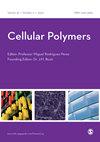注射成型轻量化高导电性复合材料与微孔结构和混合填料
IF 1.9
4区 医学
Q4 MATERIALS SCIENCE, BIOMATERIALS
引用次数: 5
摘要
采用固体和泡沫注射成型的方法制备了聚丙烯/炭黑(PP/CB)和PP/CB/多壁碳纳米管(PP/CB/MWCNT)复合材料,以提高复合材料的导电性,同时降低最终产品的成本。表征和分析了复合材料的发泡性能和通过面电导率。细胞的生长增加了导电填料的互连性,改变了填料的取向,提高了复合材料的T-P电导率。在适当的工艺条件下(熔体温度200℃,注射流量70 cm3/s,孔隙率5%),泡沫PP/CB复合材料的T-P电导率比固体复合材料高5个数量级(从5.877 × 10−12 s /m提高到1.010 × 10−7 s /m)。此外,在相同的导电填料含量(15 wt%)下,比较了PP/CB和PP/CB/MWCNT的T-P电导率值。结果表明,PP/CB/MWCNT复合材料的T-P电导率远高于PP/CB复合材料近5个数量级,这是因为MWCNT在CB颗粒之间起到了桥梁作用,并在体系中形成了独特的几何形状。掺碳量为15%的泡沫PP/CB/MWCNT复合材料的T-P电导率高于掺碳量为20%的固体PP/CB复合材料。研究表明,发泡效果和混合填料的加入可以提高塑料制品的T-P电导率,这对轻质导电塑料的发展具有重要意义。本文章由计算机程序翻译,如有差异,请以英文原文为准。
Injection-molded lightweight and high electrical conductivity composites with microcellular structure and hybrid fillers
Polypropylene/carbon black (PP/CB) and PP/CB/multiwalled carbon nanotube (PP/CB/MWCNT) composites were fabricated by solid and foam injection molding, with the goal of enhancing the electrical conductivity of the composites while decreasing the cost of the final product. The foaming behavior and through-plane (T-P) electrical conductivity of the composites were characterized and analyzed. Cell growth increased the interconnection of the conductive fillers, changed the filler orientation, and enhanced the T-P electrical conductivity of the composites. Under appropriate processing conditions (200°C melt temperature, 70 cm3/s injection flow rate, and 5% void fraction), the T-P electrical conductivity of the foam PP/CB composites was 5 orders of magnitude higher than that of the solid composites (from 5.877 × 10−12 S/m to 1.010 × 10−7 S/m). Moreover, the T-P electrical conductivity values of the PP/CB and PP/CB/MWCNT were compared at the same conductive fillers content (15 wt%). The results showed that the T-P electrical conductivity of the PP/CB/MWCNT composites was far higher than that of the PP/CB composites by almost five orders of magnitude because the MWCNT acted as a bridge between CB particles, and a unique geometric shape was formed in the system. The T-P electrical conductivity of the foam PP/CB/MWCNT composites with 15 wt% carbon fillers was higher than that of the solid PP/CB composites with 20 wt% carbon fillers. This study reveals that the effect of foaming and the addition of hybrid fillers can improve the T-P electrical conductivity of plastic products, which is very important for the development of lightweight conductive plastics.
求助全文
通过发布文献求助,成功后即可免费获取论文全文。
去求助
来源期刊

Cellular Polymers
工程技术-材料科学:生物材料
CiteScore
3.10
自引率
0.00%
发文量
9
审稿时长
3 months
期刊介绍:
Cellular Polymers is concerned primarily with the science of foamed materials, the technology and state of the art for processing and fabricating, the engineering techniques and principles of the machines used to produce them economically, and their applications in varied and wide ranging uses where they are making an increasingly valuable contribution.
Potential problems for the industry are also covered, including fire performance of materials, CFC-replacement technology, recycling and environmental legislation. Reviews of technical and commercial advances in the manufacturing and application technologies are also included.
Cellular Polymers covers these and other related topics and also pays particular attention to the ways in which the science and technology of cellular polymers is being developed throughout the world.
 求助内容:
求助内容: 应助结果提醒方式:
应助结果提醒方式:


